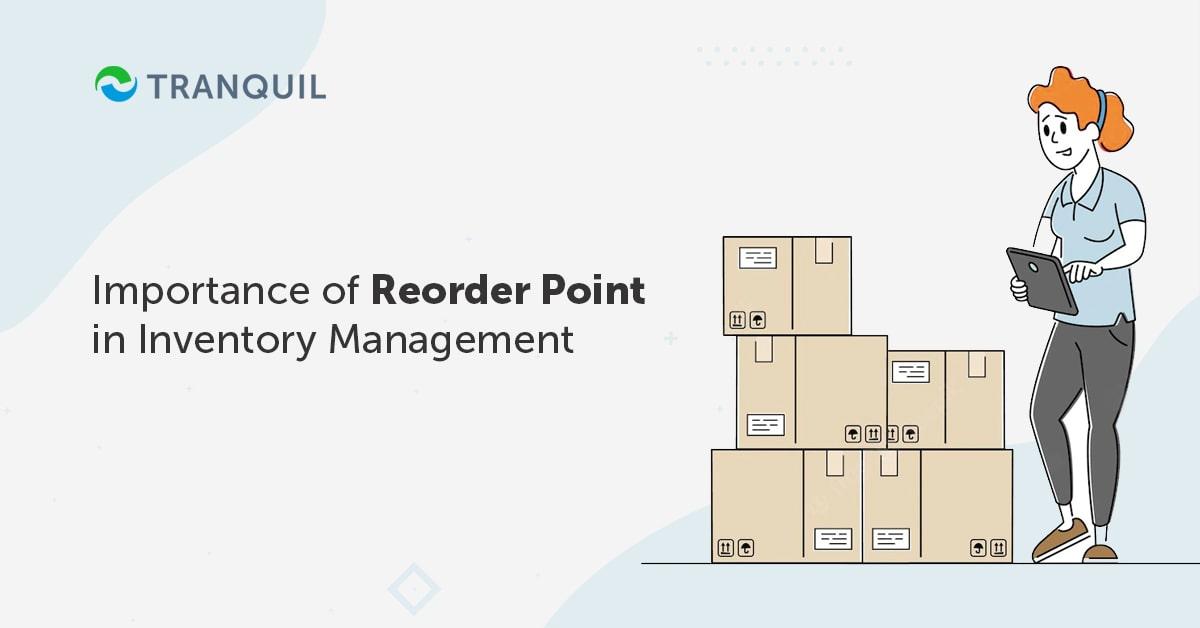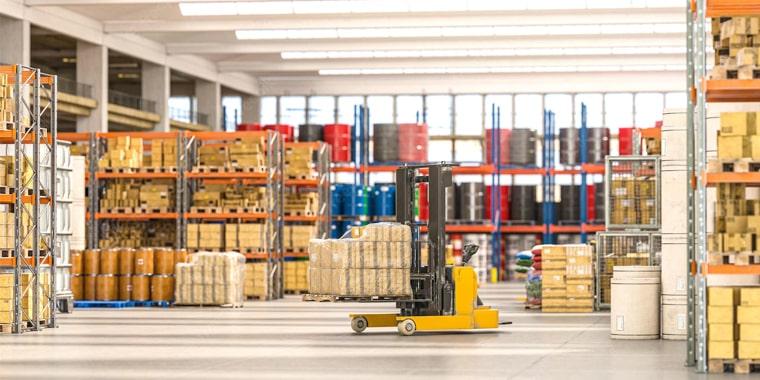
As a manufacturer, some of the questions constantly going through your head are most probably about when you should order your raw materials next, and how much to order.
As important as they are, these questions are also difficult to answer.
They are also extremely important for efficient inventory management.
Reorder Point in inventory management refers to the inventory point or level at which your stock has to be refilled.
To put it differently, ROP tells you when exactly to order materials so that you don’t get stocked out.
Usually, it is set at a level slightly higher than the minimum so that in case you face an unforeseen delay in getting delivery of the order, or have a sudden spike in demand and your present materials get used up, you are still safe.
ALSO READ: Benefits of Stock Status

You need to remember that inventory reorder point is not the same as reorder quantity.
Reorder level and reorder point are the same – the inventory level at which stock has to be ordered again.
Reorder quantity, on the other hand, is the quantity of stock to be ordered when the stock reaches the reorder point.
In other words, a reorder point is an indication of when to send a purchase order for additional stock, and reorder quantity specified the quantity of goods to be ordered.
Reorder level is more important here as you first need to establish when to place the order after considering the following factors:
Once it has been decided that the order has to be placed, then the relevant manager will decide on the quantity to be ordered after considering these factors:
Avoiding stockouts is the key risk that has to be mitigated when calculating the ROP inventory, while the per unit cost of holding inventory is the biggest concern while determining order quantity.
ALSO READ: What is Dead Stock – How Can You Avoid It?
As the owner or inventory manager, your priority should know when to order new stock.
Purchasing additional stock when you already have a lot of stock in hand will only lead to excess inventory, increasing your carrying costs.
But if you wait till your stock reaches zero to place the order, you are likely to miss potential sales, which means unhappy customers.
If your lead time – the time taken for the stock to reach you after placing the order – is long, you will end up losing even more sales.
However, if you establish a reorder point for inventory, you can ensure restock at the correct time and fulfil customer demands without being stocked out; in short, you can achieve inventory optimization.
ALSO READ: What is Storage Cost of Inventory?

You need to set reorder points for every item in your inventory, as the consumption rate of each is likely to be different.
The inventory reorder point formula depends on the following factors:
There are two ways to calculate the reorder point – with safety stock, and without safety stock.
ROP will also differ for different vendors as the lead time is likely to be different for each.
Safety stock is maintained by businesses to tide through unexpected surges in demand or delayed shipping.
ALSO READ: What is UOM in Inventory?
If you are a retailer of branded electronics, and you sell 50 laptops every day.
Your supplier requires 10 days to deliver the number of laptops you order.
Your buffer stock should last you 5 days.
Now let’s calculate your reorder point.
Lead time: 10 days.
Safety stock: 5 days x 50 laptops = 250 laptops
ROP Formula = (daily sales x lead time) + safety/buffer stock
This translates to (50 x 10) + 250 laptops
500 + 250 = 750 laptops
Here, the reorder point is 750 laptops; this means that when there are 750 laptops remaining in inventory, you need to place an order for additional laptops.
This will help you fulfil customer orders until the fresh stock of laptops arrives.
ALSO READ: Why Physical Stock Verification is Necessary?
Not all businesses maintain safety stocks.
Some businesses have a lean or zero inventory policy whereby they maintain bare minimum stock to reduce carrying costs, in such instances, you can calculate the ROP thus: multiply average daily sales x lead time.
Without safety stocks, your ROP, as well as order frequency, are typically higher.
Let us continue with the same example of the laptop retailer.
Average daily sales = 50. Lead time = 10 days. 50 x 10 = 500.
This means that you need to place an order for new laptops when there are 500 laptops remaining in inventory

Most businesses purchase materials or goods from multiple vendors, each with their own lead times.
It makes sense, therefore, to have separate reorder points for each inventory item.
Apart from laptops, let’s say you sell Bluetooth speakers and monitors.
Both are sold by different vendors and have separate lead times.
Let’s say the speakers have a lead time of 4 days and the monitors have a lead time of 12 days.
On an average day, you sell 60 speakers and 10 monitors.
Let us assume that you don’t maintain safety stock.
In that case, your reorder point for the Bluetooth speakers will be:
Average daily sales x lead time = 60 x 4 = 240 Bluetooth speakers.
You should reorder when 240 Bluetooth speakers remain in inventory so that you have enough stock to meet customer demands for 4 days.
Your reorder point for the monitors will be:
Average daily sales x lead time = 10 x 12 = 120 monitors.
This means when 120 monitors are left in stock, you should place orders for fresh stock; and you have enough monitors to fulfil customer demands for 12 days.
Reorder levels are critical for efficient inventory management.
Not only does it help you reduce carrying costs, but it also helps prevent both overstocking and understocking, and ensures you have adequate stock to meet customer demand so that you don’t lose sales.
ALSO READ: Why Distribution Management is Important?
Various models of stock replenishment are followed by different businesses, depending on their overarching inventory policy.
The policy comprises when and how much to order, among other things.
The objective of these models is hence, to establish the optimal reorder levels and reorder quantities of the different inventory items in stock.
When to order is usually fixed, or depends on when the level of an item in stock reaches a certain point, as determined by the formula we saw above.
There are ways in which both of those can be combined so that you can have a fixed schedule as well as quantity.
There are a few things to keep in mind while choosing your ideal replenishment model.
There are different aspects that will impact demand for specific products:
ALSO READ: Why ERP User Interfaces are Important?
Each type of demand will have a range of lead times, which will also affect your decision.
Your lead times could be very short or very long – and even those times may vary by vendor, season, and market condition.
You also may need to order multiple items; for example, a garment manufacturer will need to order the fabric, threads, buttons, lace, elastic, and so on.
It is quite possible that each item is supplied by a different vendor, and that even if you place the order at the same time, they may have different lead times, and arrive at different times.
Ergo, you may need to have different reorder points so that you get each item in time to produce the next batch.

Establishing reorder points ensures that you don’t get caught short for your next stock.
When there is a precise reorder point for every item, you can ensure that there is adequate stock in hand to meet customer demands.
ALSO READ: Difference Between Procurement And Purchasing
Additionally, you can also enjoy these benefits:
When a business stocks raw materials or finished products in excess of what is required to meet consumer demand, it is not a prudent usage of capital.
With reorder levels, businesses are better able to understand finances and allow them to maintain minimal inventory based on consumer demand.
While it’s true that carrying excess inventory can increase the holding costs, having too little stock puts you at risk of losing sales, and consequently, customers.
After all, customers are not likely to wait too long to receive their orders.
However, all of this can be avoided by setting reorder levels and maintaining optimal inventory levels.
You have a clear picture of when exactly to order additional goods or raw materials.
ALSO READ: Understanding Sales Management in ERP
Calculating reorder levels is inextricably linked with knowing the market trends that are prevalent in a certain period.
When you closely follow and examine the reorder level for an item, you will be able to assess the demand for that product more accurately in the future.
It also provides reassurance that you have used the available resources effectively.
ALSO READ: Inventory Management Mistakes and Tips to Avoid Them
Final Thoughts
If you are a small establishment dealing in only a couple of items of raw material or finished products, you may be able to calculate the reorder points manually and keep track of every detail.
Still, it entails a great deal of effort and time.
For an enterprise with hundreds of items, it is almost impossible.
Tranquil Cloud ERP offers an easy and convenient way of doing it. The inventory management module automates all of these functions and does much more to help you manage your inventory efficiently. Schedule a demo at your convenience so that we can tell you how it works and how your business can benefit.